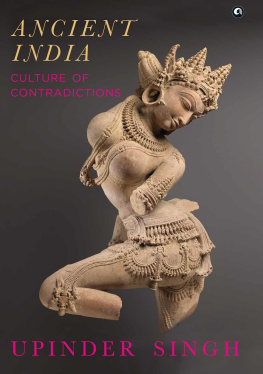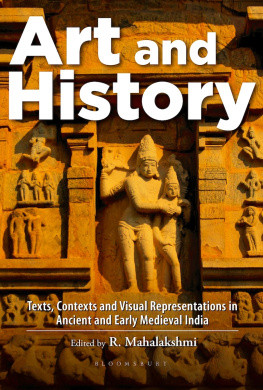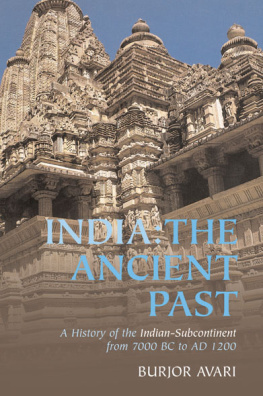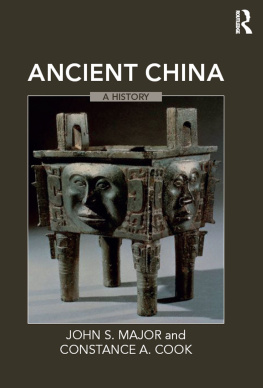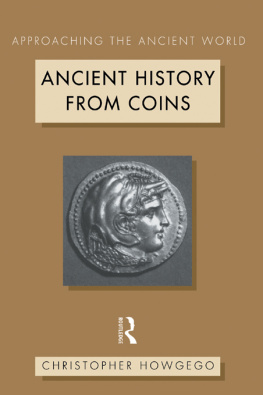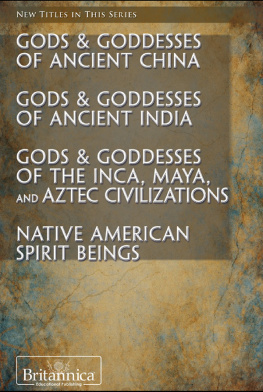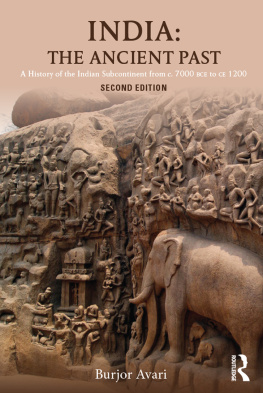A History of Ancient and Early Medieval India
FROM THE STONE AGE TO THE 12TH CENTURY
Upinder Singh
Delhi Chennai Chandigarh
Upper Saddle River Boston London
Sydney Singapore Hong Kong Toronto Tokyo
Brief Contents
Credits
Contents
THE IDENTIFICATION OF DOMESTICATION AND FOOD PRODUCTION IN THE ARCHAEOLOGICAL RECORD
Neolithicchalcolithic sites of South India
SCULPTURE AND ARCHITECTURE
The ganika and kulastri in Sanskrit kavya
What the reviewers say about this book ...
Professor Singh seems to have given us a singularly learned, well-written, and detailed introduction to the study of ancient India... It is possible to have disagreement with Professor Singh on various issues, but that, in fact, lends charm to what she writes because what would a book like this be worth unless it can generate debates in the class-room?
Dilip K. Chakrabarti, University of Cambridge
[The books] unusual format consists of not only a narrative text, but boxed information from original sources and research works, and on key concepts, which the students will find instructive.... The website for further references and reading makes a supplement to the narrative. The list of further readings is impressive.... Due attention is paid to regional histories, especially South India and sources in regional languages....
R. Champakalakshmi,The Hindu , 13 October 2008
... a well illustrated, marvellously produced textbook covering the vast history from the Stone Age to the 12th century.... Singularly impressive for its make-up and appearance, this textbook is the first of its kind in the country....
Each chapter of the book contains a critical reappraisal of sources and the development of historical knowledge ... helping students understand the rigorous methodology that underlies the process.... [U]nsettled issues have been dealt with through the debates without losing their complexity and thus creating awareness of various scholars valuable contributions towards the construction of historical knowledge....
Singhs book ... educates its readers as to how history can stake claims on various areas of knowledge in the domain of interdisciplinary studies like gender studies, environmental history, human geography, landscape archaeology and human ecology.
Rajan Gurukkal,The Book Review , October 2008
Professor Singh has succeeded in her venture of producing a balanced and stimulating textbook on the early Indian past. She has followed recent trends in historiography, incorporating into her book new theoretical perspectives, scientific technologies, and the enormously growing archaeological data. Often neglected South Indian history is also adequately represented.
N. Karashima, University of Tokyo
With its in-depth assessment of the literary and archaeological sources and theoretical discourses, [this book] provides a unique and long overdue introduction to the study of Indian history to the 12th century, which gives full coverage also to peninsular India.
Hermann Kulke, University of Kiel
This is the first work on ancient India where the text has been constructed at different levels. Ten chapters pan across the whole canvas, from prehistory and protohistory to ancient and early medieval history. The panorama is interspersed with inset capsules where some themes are picked out to illustrate larger elements in the chapters....
Singhs deep affection for all kinds of ancient Indians has ensured that ... she does not lose sight of ordinary people, or for that matter, their eating habits, or even their pets.
Early India is not merely humanised through such capsules and sources, it is also illuminated by the roughly 450 illustrations that accompany the text.
Nayanjot Lahiri,India Today , 11 August 2008
[T]his up-to-date, lavishly illustrated, and thoughtfully-designed volume is clearly the new standard against which future texts will be measured.... Singhs overview of early Indian history deftly integrate[s] archaeological data in a way few, if any, other reviews have achieved or ventured....
[Singh] stresses the complexity and diversity of experience ... while also crafting a composite image, a mosaic, of a unified Indian past. That she is able to do justice to regional specificity, occupational diversity, and cultural complexity is a testament to [her] powerful historical vision....
The most enduring value of Upinder Singhs new synthesis is the way in which it aims to create not simply consumers but producers of historical thought.
Kathleen D. Morrison,Seminar , 593, January 2009
Singh ... writes with a refreshing openness, and her constant aim is to communicate clearly, without simplifying the complex subject matter before her. [T]his is the major contribution of the book....
In an era when most historians are torn between different and contending theories, Singh remains rooted to facts and analysis without ever committing the error of claiming that she has said the last word on the subject.
Rudrangshu Mukherjee,The Telegraph , 14 November 2008
... a fascinating and up-to-date account of South Asias past, from the dim beginnings of the hunter-forager way of life to the early medieval period. It is based on an objective assessment of both literary and archaeological sources ... the book will be useful to students of history and archaeology at all levels and to all educated laymen who desire to know about South Asias past.
K. Paddaya, Deccan College, Pune
The language is refreshingly gender-sensitive and direct. The visuals are chosen with care and several of them are spectacular. Access to primary sources (both visual and textual) enriches the book enormously. It is more than apparent that the author has carefully deliberated over each sentence in order to create a text that is comprehensive.
Kumkum Roy,IIC Quarterly , Autumn 2008
The Author
Upinder Singh is Professor in the Department of History at the University of Delhi. She studied history at St. Stephens College, Delhi, and went on to receive her M.A. and M.Phil. from the University of Delhi, specializing in ancient Indian history. She obtained her Ph.D. from McGill University, Montreal.

She taught history at St. Stephens College, Delhi, from 1981 until 2004, after which she joined the faculty of the Department of History at the University of Delhi. Professor Singhs wide range of research interests and expertise include the analysis of ancient and early medieval inscriptions, social and economic history, religious institutions and patronage, the history of archaeology, and the modern history of ancient monuments. Her research papers have been published in various national and international journals. She is the author of several booksKings, Brhmanas, and Temples in Orissa: An Epigraphic Study (AD3001147) (1994); Ancient Delhi (1999; 2nd edn., 2006); a book for children, Mysteries of the Past: Archaeological Sites in India (2002); The Discovery of Ancient India: Early Archaeologist


